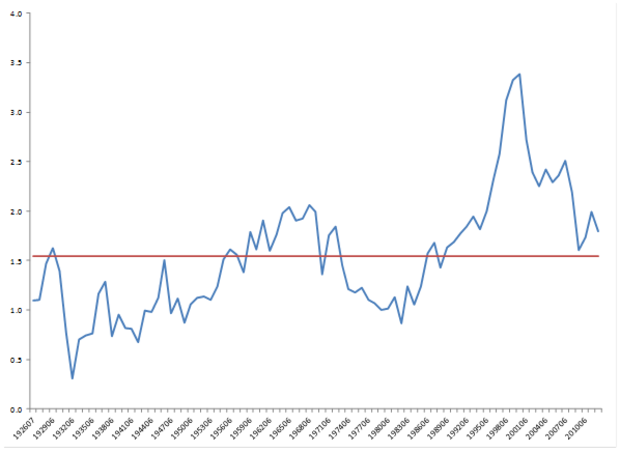Projections show smaller future stock returns
(MoneyWatch) There's been a great deal of discussion lately about the stock market's valuation and estimates of forward-looking returns. Specifically, people are focusing on the so-called Shiller P/E (which uses 10-year average real earnings in the denominator) versus the traditional P/E (which uses trailing 12-month earnings).
As Cliff Asness of AQR Capital noted in a recent paper:
... the idea of the Shiller P/E arose from the observation that one-year earnings are highly volatile and probably mean-reverting. Thus, at times of very high earnings, the one-year P/E might look 'too low' (stocks too cheap), and when earnings are very low the opposite can occur and the one-year P/E might look 'too high' (stocks too expensive). At extremes, like very bad recessions, earnings can get so low as to approach or pass zero, making the one-year P/E obviously silly. (This almost happened in 2008/09.)
The current Shiller P/E is about 20, or about 23 percent above its historical average of about 16.5.
- What the end of the American Age means for Your portfolio
- Can we predict stock returns over the long term?
- How liquidity risk affects global stock returns
The academic research shows that while no one metric is really a great predictor of future returns, we do know that relying on past returns when predicting future returns is likely a mistake. New York University finance professor Aswath Damodaran examined the period 1960-2011 and found that if past returns were higher than average, future returns were more likely to be lower, and vice versa. However, Damodaran did find that forward-looking metrics like the earnings-to-price ratio (the inverse of the price-to-earnings ratio) actually had some predictive value. The bottom line is that when forecasting long-term returns (say 10 years), which one must do to determine how much equity risk is needed to achieve their financial goals, valuations do matter.
The good news is that the current P/E ratios for stocks, both domestic and international, are below their historical averages. However, the picture is not as bright when we look at Shiller's P/E.
Asness recently took a look at this issue and found that "10-year forward average returns fall nearly monotonically as starting Shiller P/E's increase. Also, as starting Shiller P/E's go up, worst cases get worse and best cases get weaker." And when the cyclically adjusted price-to-earnings, or CAPE, ratio was between 18.9 and 21.1 (as it is now), the 10-year real return averaged 3.9 percent. Using the Philadelphia Federal Reserve's consensus forecast of professional economists of an inflation rate of 2.3 percent, nominal expected returns are only about 6.2 percent.
For the optimists out there, Asness noted that even at high CAPE ratios the best-case scenarios are still pretty good, providing hope. I would note that hope shouldn't be a strategy. Asness concluded that while the CAPE doesn't do a great job of forecasting returns, it does have value in setting expectations.
A 3.9 percent expected real return for stocks might be distressing enough for some people, but making matters worse is that most people don't hold all-stock portfolios. With current yields on safe bonds forecasting negative expected real returns, the outlook for balanced portfolios of stocks and bonds can be outright depressing. The reality is that to have a reasonable chance of achieving their financial goals, many investors will have to plan on either raising their savings rates (cutting current spending) and/or plan on working longer. And they may even have to consider taking more equity risk at a time when expected returns are below historical levels.
My colleague and "Alternative Investments" co-author Jared Kizer took an entirely different look at forward-looking returns. He put together a data series of the U.S. market's price-to-book ratio calculated using Dartmouth professor Ken French's data:
This is the first time I had seen this series. And it certainly looks right to me. As Jared notes, "The peaks and valleys are where we should have expected them to be. The most recent value of the ratio is about 1.8, which is above the long-term mean of 1.5, indicating that investors should expect equity returns to be below their long-term norm."
The bottom line is that while forecasting stock returns is at best an inexact science, it seems prudent for investors to plan on stock returns that could very well be several percent below their historical average.
Image courtesy of Flickr user Images_of_Money
